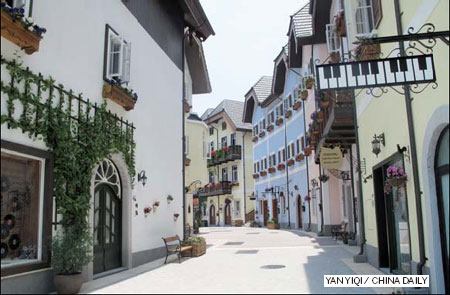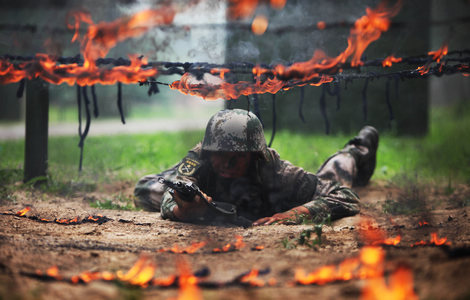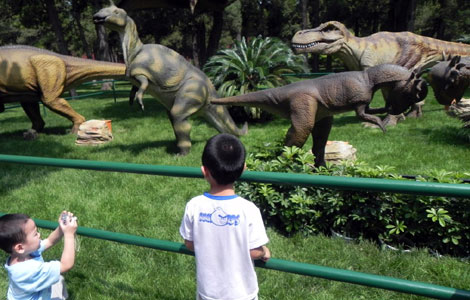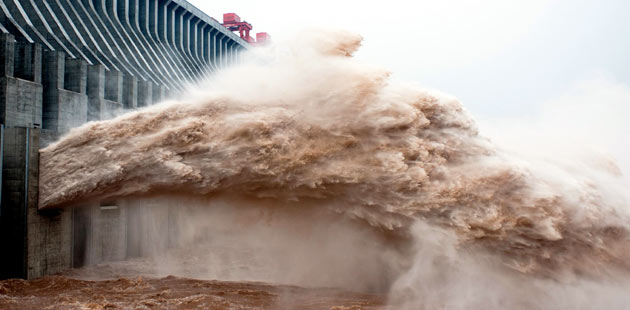Taken in by the Chinese copycat
Updated: 2012-08-24 09:23
By Yan Yiqi (China Daily)
|
||||||||
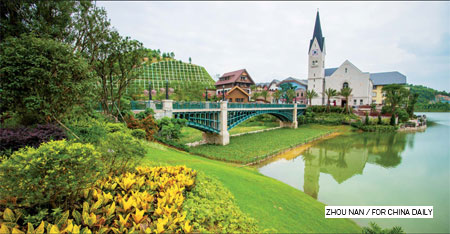
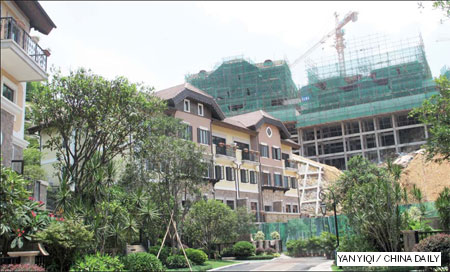
|
Clockwise from far left: The cloned Hallstatt Villa project in Boluo county, Huizhou. Some residential houses surrounding Hallstatt are still under construction. Photographic studios, bars, hotels and restaurants have signed on to enter the project's business area. |
Related reading: Homes from home
If it's schnapps at the lakeside by moonlight, we must be in Austria. No we aren't.
Lu Jun has been a taxi driver for more than 10 years. In Boluo county, Huizhou, in Guangdong province, the preferred mode of transport is motorcycle or scooter, so Lu's customers tend to be non-locals. For the past five months Lu has had a lot of passengers heading for a common destination: a strange piece of real estate in the county's east.
"You're something like the eighth person I've driven to that place, but I don't know what the point is of going there," he says. "It's far from downtown and there's no sealed road. I used to take passengers there when it was raining, and it's muddy." Lu cannot figure out why anyone would want to buy into this real estate project, where the price of houses is triple the price for the best houses elsewhere in the county.
After a 15-minute taxi ride, the last small stretch of which takes us over the jaw-juddering unsealed road Lu had talked of, the eerie sway that this place has over investors becomes clear. It seems we have arrived not in a far-flung outpost of southeastern China, but in a picturesque rustic village nestled in central Europe. We are at Hallstatt Villa, which aspires to be a "complete illustration" of the village of Hallstatt, in the Salzkammergut region of Austria - minus the UNESCO cultural heritage credentials.
Imitation may well be the ultimate form of flattery, but Hallstatt Villa has attracted little but controversy since construction began last year.
In July last year, China Minmetals Corp announced that it would invest 6 billion yuan ($942 million, 768 million euros) in the Hallstatt project.
"The core spirit of the real Hallstatt was not formed within one day," Ma Yansong, founder of MAD Architects in Beijing, was quoted as saying in an earlier interview. "It has a history of more than 7,000 years, and simply copying its construction style cannot bring essential culture to the buildings. Chinese architects (need) to work out original constructions."
Ma made his remarks after widespread criticism of the project. One of those critics is Chen Yunfeng, secretary-general of the National Real Estate Manager Alliance, who, while seeing the commercial benefits, says Chinese real estate developers need to learn from foreign experience, not by simply cloning.
"The core competence of real estate projects is original design, including transforming excellent foreign projects into local ones that are suitable to local clients," he says, adding that learning the spirit rather than the format is essential.
It may have taken 7,000 years for the real village to develop its spirit, but it is clear that with the copycat version, project managers have a shorter time span in mind. After little more than 10 months' construction work, the marketplace is already complete.
"Except for one thing: that there are no people around," says Stefan Pedersen a Danish artist who has traveled to Boluo specifically to visit Hallstatt Villa. "Some of my friends in Austria read the news on the Web and asked me to come and see it myself during my trip to China."
Pedersen, who studied in Austria for a year, is impressed with the marketplace, and that it, and other completed areas, are so similar to the real thing, although he does not see the point of a duplicate Hallstatt.
A handful of people in Hallstatt Villa this day stroll around under a hot summer's sun inspecting the construction site, to the strains of Johann Strauss' The Blue Danube blaring out over a speaker system. Also on hand are security guards who get around in electric cars and who are dressed, of course, in Austrian-style suits.
Trees recently planted on both sides of the long drive leading to the estate's main entrance are still too small to offer much protection from the sun, and the hills on which the village sits are literally pale imitations of the original. In Austria, mountains soar over the village and are characterized by blanched rock faces in summer and snow in winter. In Boluo's Oesterreich lite the only trace of white that is visible is the concrete reinforcing in the heavily engineered and manicured hills.
Climbing and ascending small hills and walking across a small wooden bridge, you come to the famous marketplace and the Lutheran church. But as with everything in Hallstatt Villa, the clerical dress in which this building is garbed is a facade. The church has no religious function but is a luxuriously decorated sales office that will later be turned into a private club. The interior decoration is more Rococo than Hallstatt.
The houses surrounding the church, which are still being built, give a fuller picture of the true nature of Hallstatt Villa: a sprawling residential estate on which hundreds of houses will eventually be located.
"I thought there would be surprise, but it is so boring," Pedersen says after a two-hour bus drive from Shenzhen and a tricycle ride from the bus station. There is not even a restaurant where you can get a bite to eat, he says.
"I can see they are trying very hard to copy every detail of the real Hallstatt, but there is still much improvement to do," he says, pointing out a misspelled German word on a shop sign.
Pedersen says it is understandable that locals would buy villas here, given how unusual it is, but for people outside Huizhou, he sees no reason to come.
Some local residents also cannot understand the point of the exercise.
Gao Jieyun, who works in Dinghuang Hotel in Boluo, says she visited the village in May out of curiosity. "As a local, I don't like the idea, because it does not fit the style here. Why don't they build houses in the Boluo style?"
Boluo is a county under the city of Huizhou, which is a two hours' drive from the city of Shenzhen. The county is no larger than 3,000 square kilometers, and its GDP was 35.4 billion yuan last year, accounting for one-third of Huizhou's GDP, and 0.7 percent of the GDP of Guangdong province. Two small bus stations connect the county with other cities.
Shangye Street, Boluo's main thoroughfare, is lined with buildings no more than 15 stories high, and if there are any large restaurants they cannot be seen. About 1 km from the northern end of the street stands a medium-sized stadium, to the east of which are new residential complexes.
"Most of them are sold out, but almost no one actually lives there," Lu says.
Within five minutes' drive of the stadium the Hallstatt Villa construction site, at the foot of a series of hills, jumps into view.
Liu Ting, one of three local visitors when China Daily visited the site, points to the hills and says they used to be much larger. "The company dug out almost half of the hills to build those villas. Even if I could afford one, I definitely wouldn't buy one. It rains heavily here in summer days, and I don't want to put my family under the threat of a mudslide."
Many locals of the Austrian Hallstatt are also unhappy with Hallstatt 2.0, as they refer to the Chinese interloper.
"Controversially, the Chinese copy was made without notifying, let alone asking permission of anyone in Hallstatt," the New York Times reported this month.
The Mayor of Hallstatt, Alexander Scheutz, tells China Daily that he was first told of the Chinese project on May 5 last year in an e-mail from Christian Schierer, Austrian economy delegate in Hong Kong.
"But I was further informed that the design team of the China Minmetals Corp visited Hallstatt in September 2010. On June 10 the owner of the See Hotel, Monika Wenger, suddenly informed me that one of her guests who works for a Chinese company collaborating in this real estate project said that it (was just about to be built)," he says.
Scheutz says the guests showed plans, sketches and drawings that showed the planned construction of the marketplace, including Holy Trinity of Christ Lutheran Church and the See Hotel.
"Wenger, however, was very upset that all these have been secretly done without having spoken with the owners of the 'objects'," he says.
Karin Hoell, who lives in Hallstatt, says it is unacceptable that her hometown is being replicated. "Hallstatt's culture and traditions are unique, and they cannot be copied."
However, the controversy has brought plaudits for the project, and benefits to the real Hallstatt. In fact the Hallstatt local government says it sees great opportunity in cooperating with its Chinese counterpart.
Scheutz says he believes the project presents a tremendous opportunity for Hallstatt's tourism. "For us as a small village in the Salzkammergut region, it is an honor for us to have the attention and appreciation of China."
Only 47 Chinese had been to Hallstatt before 2005, he says, but last year, when the issue arose, 8,700 visited.
"This project has brought worldwide attention to our site, triggering huge media interest. As mayor I have used this opportunity to present both Hallstatt's scenic beauties and the great historical past of more than 7,000 years."
On June 2 the township of Hallstatt, county of Boluo and China Minmetals Corp signed a memorandum of cooperation in Boluo. It is aimed at promoting exchanges in culture, arts, tourism, environmental protection, education and city management.
"I hope that the three parties will continue to be in good contact with each other," Scheutz says. "On the Austrian side we offer our decades of experience in the field of tourism. We are always ready to make appropriate offers, and dedicate ourselves to our guests from China with our knowledge."
Scheutz says Hallstatt is ready to offer great experiences to international travelers all year round.
China Minmetals Corp has also benefited from the controversy.
Li Jun, senior salesperson with Hallstatt Villa, says more than 380 villas have been sold since April 15. A total of 400 units were available in the first round of sales, covering an area of 360,000 square meters. The average price is 10,000 yuan per sq m, compared with the highest housing price in Boluo of about 3,000 yuan per sq m.
"We have two types to sell for this round. The smaller one, 200 sq m, costs about 1.9 million yuan, and the larger one, 360 sq m, costs at least 5 million yuan."
All of the 400 villas will be finished and handed over to their owners by November next year.
"This place will be very lively, since most of the buyers are from Boluo or Huizhou, because they are familiar with the environment," Li says. "Also, we have buyers from Shenzhen and even Hong Kong, since the price we offer is much lower than those in first-tier cities, about one-20th."
Li says the project can also generate "feelings of home" in foreign expatriates in China.
Seventy percent of the buyers plan to live in the villas, 20 percent are buying them as an investment, and the rest want them for their retirement many years from now, he says.
There will be five more rounds of sales over the coming three years, and the whole project, with a total area of more than 1.1 million sq m, will be the largest villa complex in Huizhou, Li says.
Shi Lingyun, deputy general manager of China Minmetals Corp's Huizhou branch, says photographic studios, bars, hotels and restaurants have also signed on to enter its business area. The company also plans to turn the place into a tourism hot spot.
"I cannot say the more controversy the better, but those different voices have indeed brought us some interesting benefits. The original intention was to build a normal high-end villa complex, but later we discovered there is a great opportunity to attract more business partners and develop tourism."
Shi says he is confident an increasing number of well-established brands will gradually enter the Hallstatt Villa. "With the cooperation with the real Hallstatt town, we will go on working to make this project with more Austrian flavors, and at that time, more people and business opportunities will come."
To publicize the project the company is holding photo contests and food festivals on the site right now. Its weibo, the Chinese version of Twitter, for this project had more than 19,000 followers, up to Aug 17, uploading photos for the contest.
The Austrian village, too, is cashing in on the new burst of fame the Chinese have given it. Its tourist website sports the slogan "Hallstatt: the original. Photographed millions of times, copied once, but never matched."
Meng Jing contributed to this story.
yanyiqi@chinadaily.com.cn
